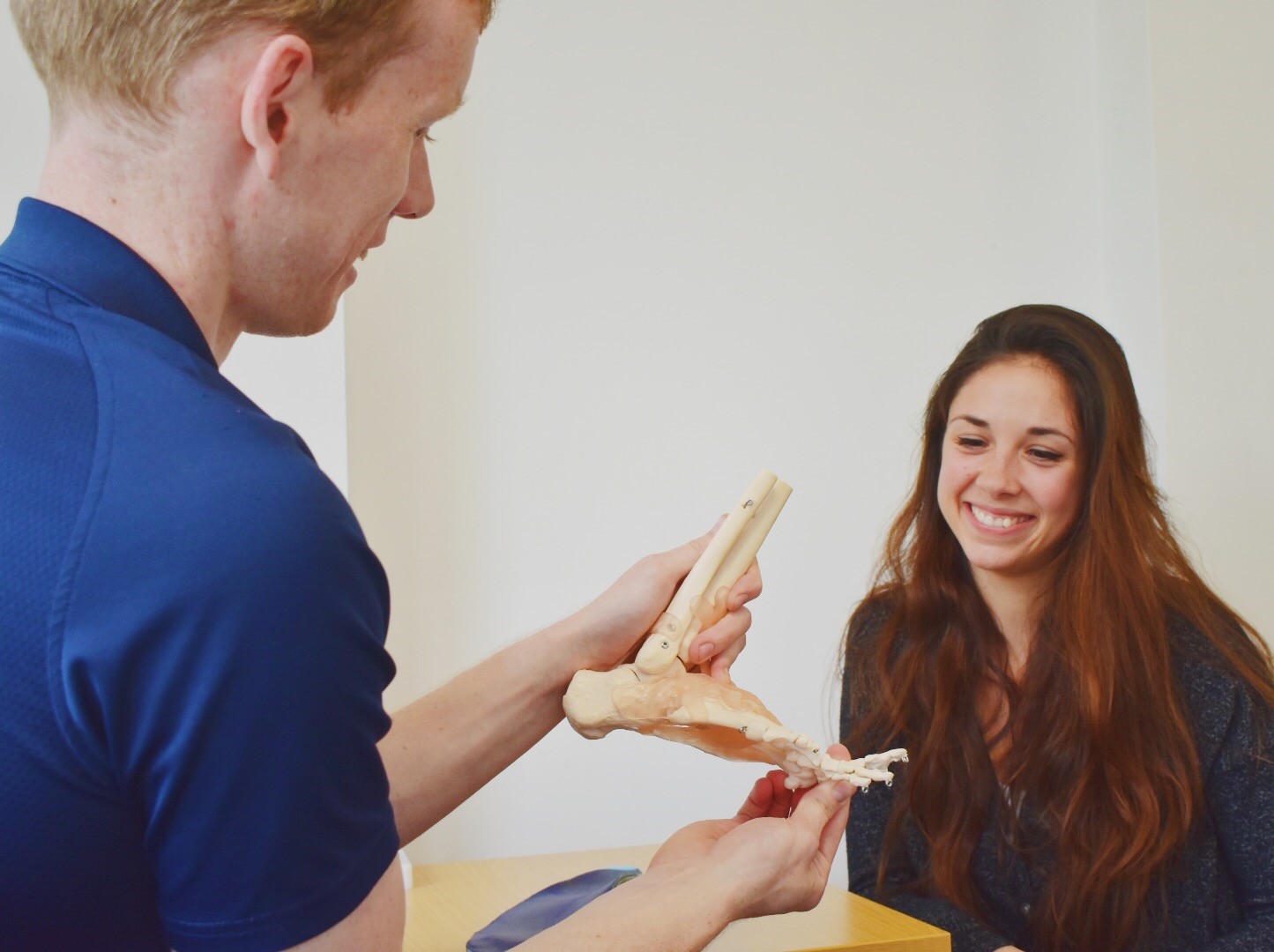
Plantar fasciitis
The plantar fascia is a fibrous layer of connective tissue which runs along the bottom of the foot, attaching the calcaneus (heal bone) to the phalanges (toes). This layer becomes taut during walking and running and helps in propulsion forward during the toe-off part of gait. It helps to keep the arch of the foot in the correct position and helps in acting as a shock absorber during walking/running.
Pathology
Plantar fasciitis, sometimes called plantarfasciopathy or chronic plantar heel pain (CPHP), is a musculoskeletal disorder which affects the fascial enthesis (where the tendon connects to bone). It causes pain in the heel and bottom of the foot. It is a self-limiting condition which means the length of symptoms depends on the patient. It can last 3-6 months in people who can change the main aggravating factor. However, it can take 1 year to resolve in patients who cannot avoid what aggravates the injury (Sullivan et al, 2015). It affects 1 in 10 people in their lifetime but 90% of cases will resolve within 1 year (Monteagudo et al, 2018). Most acute cases can be seen in people who are more active (runners) where repetitive strain (overuse) is caused by running. High training volume or increasing training volumes too quick can cause this to occur. We also know that pain can also be caused by age-related changes and thickening of the plantar fascia.
It is thought to have 2 stages: pain dominant and load dominant stages. During the pain dominant stage (1) your heal will be sensitive to any pressure/load placed on it. It will be stiff and painful first thing in the morning. Your pain will usually be worse during long periods of standing or walking/running long distances. This can last for 1-2 weeks but can go on for up to 6-8 weeks if you cannot avoid what aggravates the injury.
During the load dominant phase (2) you will see a reduction in the pain first thing in the morning, and you will be able to walk further without symptoms (Riel et al, 2017). Symptoms will generally be okay during this phase once you do not overload your plantarfascia i.e. too much running/walking too soon. At this stage, it is very important to continue to consult your physiotherapist to help with strengthening back up your foot and reintroduce loading to your foot. This is sometimes not done as you may not feel as much pain
Factors which may contribute to plantarfasciitis/plantarfasciopathy include reductions in foot and ankle strength ( small foot muscles and calf/soleus strength), reduced ankle and foot flexibility (calf length and plantarfascia length) high BMI and foot biomechanics (Sullivan et al, 2015) (Van Leeuwen, et al, 2016).
Treatment
In our clinic it is the most common foot complaint I see but more often than not we can help improve pain and manage the condition with a mixture of exercises, orthotics and manual therapy. As a clinician it is a puzzling condition to treat and diagnose as there is no one treatment which can guarantee results. But it is important to look at any other factors which may potentially contribute to symptoms. The definitive diagnosis of plantarfascitis is hard to give without imaging (ultrasound) to confirm its presence. Therefore in clinic I would usually refer to it as plantar heel pain (Riel et al, 2017).
In the different phases of the condition my approaches will be different. During the pain dominant phase treatment aims will be to reduce pain and reduce/modify what aggravates your heal. The use of custom orthotics can help to change the pressure/load from the heal so that it does not aggravate it while walking/running. The use of taping to change loading in the foot can also be beneficial. Soft tissue release again can be beneficial for some patients as it helps to reduce tightness in the calf and soleus region.
During the load dominant phase I will begin to develop load baring capacity in the lower limb. This gradual programme of strengthening for the lower limb can help allow a return to sport and activity without any flare ups of the condition. A study by Rathleff et al (2015) looked at a graduated loading programme for 3 months in patients with plantarfascitis. The patients reported improved self-reported pain after carrying this out. The programme I develop will be individual to each patient as everyone has different capacities so it is important to remember it does take time during this phase but strengthening does work.
If you pain is not improving after 2-3 months you may not have plantarfascitiis. There are many other different conditions which may present with heal pain so it is important to get a physiotherapy assessment if you are unsure. You can book with me online at www.physio4life.co.uk or contact the clinic on 02087045998 to get in for an assessment with me.
John Ross

Senior Chartered Physiotherapist
References
Sullivan et al. 2015. Musculoskeletal and Activity-Related Factors Associated With Plantar Heel Pain
Nielsen et al. Predictors of Running-Related Injuries Among 930 Novice Runners.
Van Leeuwen, et al. Higher body mass index is associated with plantar fasciopathy/‘plantar fasciitis’: systematic review and meta-analysis of various clinical and imaging risk factors.
Riel H, et al Is ‘plantar heel pain’ a more appropriate term than ‘plantar fasciitis’? Time to move on
Monteagudo et al, 2018. Plantar fasciopathy: A current concepts review.
Rathleff et al, 2014. High-load strength training improves outcome in patients with plantar fasciitis: A randomized controlled trial with 12-month follow-up: HL strength training and plantar fasciitis.



